
The Retrogaming Times
- The Bimonthly Retrogaming Hobbyist
Newsletter -

The Retrogaming Times
- The Bimonthly Retrogaming Hobbyist
Newsletter -
|
The warm summer months are upon us which tend to mean time outdoors, getting away for awhile, and vacationing under clear skies. Looking at our Upcoming Events listing it also apparently means lots of classic gaming shows and expositions. As for myself, I will be attending California Extreme for the eleventh consecutive year at the end of July. Just look for the guy who can never seem to seal the deal in Super Don Quix-ote and looks like he's spazzing out while playing Gyruss. Do you have specific summer gaming plans or memories? If so, send me an e-mail and let me know!
More C64! leads off with Merman reviewing the reintroduction of the Commodore 64 in a compact package as THEC64 Mini. Clash swords in a classic arcade game based around three types of bladed combat in Arcade Obscure. Mateus Fedozzi recalls his first experience playing Star Wars for the Brazilian Sega Master System with another great Master System Memory. In our cover story, Eugenio "TrekMD" Angueira returns to document the ever continuing history of Pac-Man games on the Atari 2600, both official and homebrew. Todd Friedman takes a look at the ColecoVision's unique controller in The Controller Chronicles. We also have a piece on the importance of Toys "R" Us to classic gaming as they wind down American operations. All that and more are ahead in this issue of The Retrogaming Times.
I want to again remind our readers if they
have comments or questions about anything covered in the newsletter, or
there is something they would like featured in a future issue of The Retrogaming
Times, to let us know via The Retrogaming Times on Facebook at facebook.com/theretrogamingtimes
or contact me directly at trt@classicplastic.net!
Follow @TRTInfoClub
on Twitter for release notifications and immediate newsletter updates!
Of course submissions are also always open. If you have something
ready to go, the address is the same, trt@classicplastic.net. "If
there is something you want to write about, send it in!"
|
Video Game Summit, July 14th 2018, Villa Park, Illinois, USA
Remember how much fun you used to have playing Atari, Nintendo and all kinds of games on your computer? Well, you will have the rare opportunity to play these great games again at the Video Game Summit, Chicago's premier video game trade show.
The Video Game Summit, now in its 15th year, brings together classic and modern generation gamers from all over the country to swap stories and games. Best of all, admission to The 2018 Video Game Summit is only $10.00 per person (kids 12 and under with adult is free). We will have Early Admission this year again due to positive response from last year.
The Video Game Summit is being held on July 14th, 2018 from 10 am until 6 pm at The Odeum Expo Center, 1033 North Villa Ave., Villa Park, Illinois.
For information on the show visit us at: http://www.VideoGameSummit.net
~ ~ ~
KansasFest, July 17th - 22nd 2018, Kansas City, Missouri, USA
KansasFest is the world's only annual convention dedicated to the Apple II computer that revolutionized the personal computing industry. Held every year in Kansas City, Missouri, KansasFest offers Apple II users and retrocomputing enthusiasts the opportunity to engage in beginner and technical sessions, programming contests, exhibition halls, game tournaments, and camaraderie. Any and all Apple II users, fans, and friends are invited to attend this year's event.
This year marks the 30th time that this event has been held. In July 1989, Resource Central held the first A2-Central Developer Conference, focused on the individuals and companies who were still producing hardware and software for the Apple II and IIGS computers. Within a couple of years, the event transformed into a conference for Apple II developers and users alike.
This year, KansasFest welcomes back one of its alumni, Roger Wagner. Though 2018 will mark Wagner's third time as a keynote speaker for the event, most current attendees haven't had the opportunity to hear him speak because his last appearance was 23 years ago. He has deep roots in the Apple II community, back to the beginnings of the platform.
For more information, visit http://www.kansasfest.org/
~ ~ ~
ReplayFX, July 26th - 29th 2018, Pittsburgh, Pennsylvania, USA
Gamers behind the Replay Foundation & PAPA are taking over the David L. Lawrence Convention Center and filling it with more than 1,000 full-sized modern and classic arcade and pinball machines, over 2,000 retro console games playable on more than 250 console gaming stations dating from the 1970’s right up to the newest consoles like the XBox One, Nintendo Switch, and PS4, an entire section with dozens of tables dedicated to tabletop and board games, a showcase of new products by game developers, magicians, live musicians, balloon artists, face-painters, competitions offering over $110,000 in prize money, and more!
The Replay FX Arcade & Video Game Festival will feature the largest public collection of working pinball, arcade, tabletop, and console games anywhere in the solar system, and all games are free to play with the price of admission! Attendees are also invited to attend a series of seminars dedicated to gaming and its associated tech-culture, browse merchandise in the marketplace, watch the world's greatest pinball wizards compete in the Pinburgh Match-Play Championship, or enjoy a series of fun and wacky daily challenges at no additional cost!
Replay FX will include multiple live musical performances, a high-energy cosplay contest, inflatable obstacle courses, and more in a show floor packed with over a quarter-million square feet of entertainment! Over $110,000 will be at stake for the competitive player. Thousands of games will be available for the casual fan. A family-friendly atmosphere will be available for the kids, and no one has to leave the galaxy to attend!
For more information, visit https://replayfx.org/
~ ~ ~
California Extreme 2018, July 28th - 29th 2018, Santa Clara, California, USA
California Extreme is pleased to announce July 28-29, 2018 as our official dates for the 2018 California Extreme Arcade and Pinball Show. It will be held at the same fantastic location - the Hyatt Regency in Santa Clara, California. Please join us for our 22nd show with hundreds of your favorite arcade and pinball games, both past and present, all gathered together for another fun-filled weekend of pure arcade excitement for folks of all ages!
We are working on this year’s lineup of seminars, guest speakers, and other arcade-themed events that make the show so much fun each year. Pre-registration is currently open!
Start making your plans, requesting time off work, making reservations by planes, trains, automobiles, and especially trucks to come out and join us for another crazy, arcade-filled weekend!
For more information, visit http://www.caextreme.org/
~ ~ ~
Retropalooza, September 29th - 30th 2018, Arlington, Texas, USA
A celebration of all things retro! Retropalooza was started in 2013 in Arlington, Texas by a couple of guys who enjoy all things retro; from toys to music, to video games... especially video games. As video game collectors, they spent a lot of time and money looking for retro games when they figured it would be easier to bring the games to them. Thus, Retropalooza was born.
The goal of Retropalooza is to bring nerds from all walks of life together for an enjoyable, family friendly time. Good old fashioned fun with like minded people where it will always be affordable, and forever improving.
For more information, visit http://retropalooza.com/
~ ~ ~
If there is a show or event you would
like listed here, free of charge, please contact David directly at trt@classicplastic.net.
Please include a short official blurb about your event along with any relevant
links or contact information and it will be published in the next issue
of The Retrogaming Times. The event listing will remain posted until
the issue following the event date. Big or small, we want to promote
your show in our newsletter. Check out these great events, shows,
and conventions and let them know you read about them in The Retrogaming
Times!
|
There has been a spate of new "mini" consoles
recently, with Nintendo shipping small versions of its NES and SNES, and
companies such as Sega and SNK following suit. THEC64 Mini is not
the first "plug & play" version of the C64 though. That honour goes
to the C64DTV, which was shaped like a joystick and housed 30 games (plus
a few Easter eggs). The major differences with the new Mini are its shape
(designed to look like a miniature C64) and the HDMI output for modern
TVs. The device was the result of crowdfunding efforts on Indiegogo to
create a plug & play C64, but when insufficient funds were raised for
a fully working keyboard the Mini was the compromise. The company behind
it are selling the Mini (and gifting it to backers) to raise more funds
to complete the project. This overview is based on my first few hours with
the device.
UNBOXING
First impressions are good, the packaging is nicely designed and clearly presented. The blue and white box resembles a classic Commodore 64 package, while the back lists the games included and some of the major features of the hardware. One important thing to note is that there is no power adapter included - power is drawn through a USB connector. Many modern TVs have at least one USB port that can power this, or a special plug/adapter (with an output of 5V AC) for your country/region can be used.
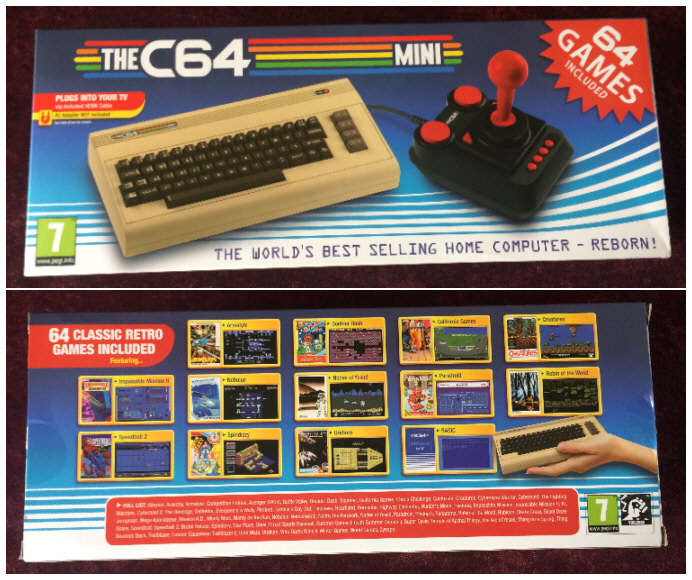
The front and back of
the C64 Mini box.
Opening the box reveals an inner box that
slides out. Immediately inside you can see the miniature computer and the
USB joystick, which has a 1.5m cable. Beneath the trays containing these
is a compartment with the two cables (1.2m HDMI and 1.2m USB lead for power)
and the Quick Guide. This is in multiple languages (English, Italian, French,
German and Spanish), with a more detailed manual available online.
SET-UP
Setting up the Mini is very straightforward. The two USB ports and the power button are on the right hand side, while the USB power cable and the HDMI cable fit into the back of the machine. Plug the HDMI cable from the computer to the monitor/TV, connect the power cable to a USB port or adapter, plug in one or two joysticks (extra joysticks can be purchased separately, but there are only two ports) and switch on. Half the games have a two-player option using a second joystick, while a dozen or so allow two players to share the same joystick taking turns.
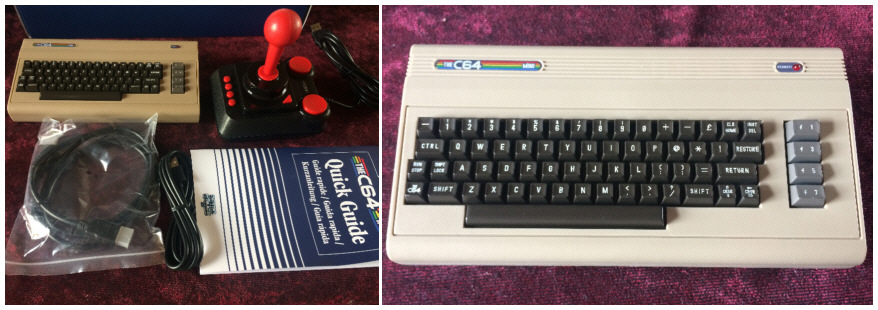
The contents of the box,
and the C64 Mini itself (the keys do not work).
The Mini comes with a well-presented menu system, based around the blue & white colours. The first menu chooses the region/language, which is remembered by the console after switching off. (It can be changed later). The main menu allows the user to change settings and select a game, or enter Commodore BASIC mode. There is the option to attach a USB keyboard (and select its layout) for games that require keys and typing in BASIC. Otherwise the player has to use the virtual keyboard, which can be cumbersome. Choosing one of the in-built games brings up a brief description of the game including artwork and screenshots. Each game has four "save slots," accessed from within the game by pressing the Menu button, allowing the player to return to that point later.
The emulation of the C64 in the Mini has some optional graphic filters, for changing the way the Mini outputs to the TV. The "Pixel Perfect" option is the default. European or North American 4:3 ratios are available. The CRT (Cathode Ray Tube) settings give the illusion of running the device on an older TV, adding scan lines. The menu has music by composer Matt Gray, which can be turned off. The Hall of Fame selection reveals a scrolling list of backers in the crowdfunding campaign, done in the style of a C64 demo (with more Matt Gray music). When a game is started, there is a brief black screen before it starts. If the game has to access the disk, a small white icon flashes at the top right of the screen while loading is in progress.
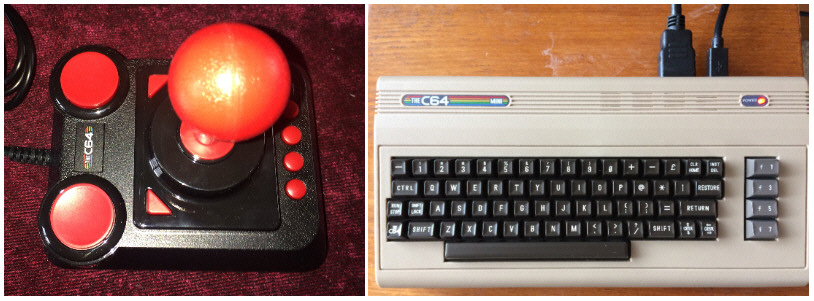
A close-up of the joystick
with its extra buttons, and the console set up.
LET THE GAMES BEGIN
The selection of games included has some interesting choices, and many of these titles had previously been part of the C64DTV. (Darren Melbourne was responsible for licensing the software included on both the Mini and the DTV). What is good news is that royalties are being paid to the original creators.
American software house Epyx is well represented with classics including the brilliant Impossible Mission, racing game Pitstop II and Summer Games II (cleverly this includes the option to play events from the original Summer Games as well). Hewson were the company behind several more great games included here, such as the Andrew Braybrook classics Paradroid and Uridium. Shaun Southern has the great Trailblazer and its follow-up Cosmic Causeway on there. Gremlin are also represented by Thing on a Spring and Monty on the Run (both featuring superb Rob Hubbard music), and Bounder (which recently made a comeback as an iOS and Android app). It's also fun to see chase game Star Paws on there. The two Speedball games are great for solo play, but even better with a second joystick.
However, some of the selections are a little odd. Skool Daze heavily relies on the keyboard, and the Spectrum-style graphics are not a showcase for what the C64 can achieve. (Something like Nebulus AKA Tower Toppler does a much better job, with its amazing rotating towers and cute graphics). The Temple of Apshai trilogy, enhanced versions of the early Epyx roleplaying games, is another choice that really needs keys. The Odin titles (Arc of Yesod, Heartland, Mission AD, Nodes of Yesod and Robin of the Wood) have dated badly despite their good looks and excellent Fred Gray music. Hysteria from Software Projects is decidedly dull, while Uchi Mata (the judo simulation from Martech) is incredibly difficult to play without knowing the moves.

A view of the menu with
Star Paws selected, and Super Cycle in action.
There has been a lot of negative comment
online about the USB joystick. It is not the best controller and feels
a little flimsy, but is responsive enough for the games requiring quick
movement. It may not stand up to a lot of punishment, particularly in the
Games events that require waggling the stick back and forth. One good feature
is the additional buttons on the back, used to gain access to the menus
and make selections. (The rightmost button on the back is designated the
Menu button and gets the most use). The main fire buttons can be held down
for certain games and fit comfortably for left or right-handed use. The
cable length is also helpful, letting you sit further back from the TV.
There have been users online trying other USB controllers, so it is worth
searching to see if something else will suit the player better. Some users
have reported input lag, made worse by the settings of their TV. This was
not something I spotted during my short time with the device so far, but
it is worth bearing in mind.
AND THERE’S MORE
New firmware and software for the Mini is promised in the future. This can be added to the device using a USB stick or flash drive. It is also possible to run games from the USB stick, and to save and load BASIC programs to and from such a device. However, this is currently limited to ONE file per stick. There are ways around this.
For Mini resources and extra files, the
website of C64 fanzine FREEZE64 should be an early port of call. Vinny
Mainolfi has provided "joystick hacks" for games that require port 1 (as
the Mini does not recognise a single stick as being in port 1) and a range
of "multi-game" disks. These contain single-file games that can be started
from the BASIC option of the Mini, circumventing the restriction of one
file per stick. However, you can still only have one multi-game disk available
at a time without renaming the file(s) via a computer/laptop.
VERDICT
THEC64 Mini is a good attempt at reviving interest in the C64. For hard-core C64 fans it is not currently an essential purchase. For those who know a few games or want to experience some classic titles, it is an easy entry point. The HDMI output is a key feature in what does appeal about the Mini, making it compatible with modern TVs. With an easier way to add or download games it would be a hit - here's hoping that the full-sized version will live up to these expectations.

For fun, I thought I
would use the Retrospecs app for iOS (created by John Parker) to edit a
couple of the photos I took of the C64 Mini.
Retrospecs can filter
and edit photos to look like classic computers, in this case with the resolution
and colour palette of the C64.
WEB LINKS
www.thec64.com/
- The official website, including firmware
updates
www.thec64.com/buy/
- Links for retailers in various countries
(not currently available in the USA)
www.facebook.com/groups/209280506324242/
- Official Facebook group for THEC64 Mini
www.c64minicommunity.freeforums.net/
- Free forum for fans
www.gurce.net/c64mini/
- C64 Mini Wiki, updated with lots of
useful compatibility information
www.freeze64.com/c64mini-hacks/
- The FREEZE64 site with its dedicated
C64 Mini hacks and multi-disks, created by Vinny Mainolfi (Check out the
brilliant fanzine too, dedicated to C64 cheats and hacks, with lots of
other interesting articles too.)
www.8bitartwork.co.uk/
- The Retrospecs website
THEC64 MINI GAMES LIST:
Alleykat, Anarchy, Armalyte: Competition Edition, Avenger, BASIC *1, Battle Valley, Boulder Dash, Bounder, California Games, Chip’s Challenge, Confuzion, Cosmic Causeway (Trailblazer II), Creatures, Cyberdyne Warrior, Cybernoid: The Fighting Machine, Cybernoid II: The Revenge, Deflektor, Everyone’s A Wally, Firelord, Gribbly’s Day Out, Hawkeye, Heartland, Herobotix, Highway Encounter, Hunter’s Moon, Hysteria, Impossible Mission, Impossible Mission II, IO, Jumpman, Mega Apocalypse, Mission A.D., Monty Mole, Monty on the Run, Nebulus, Netherworld, Nobby the Aardvark, Nodes of Yesod, Paradroid, Pitstop II, Ranarama, Robin of the Wood, Rubicon, Skate Crazy, Skool Daze, Snare, Speedball, Speedball 2: Brutal Deluxe, Spindizzy, Star Paws, Steel, Street Sports Baseball, Summer Games II (with Summer Games I events), Super Cycle, Temple of Apshai Trilogy, The Arc of Yesod, THEC64 Hall of Fame *2, Thing Bounces Back, Thing on a Spring, Trailblazer, Uchi Mata (Judo), Uridium, Who Dares Wins II, Winter Games, World Games, Zynaps
*1 this is the option to enter BASIC
*2 this is the "demo" listing the names
of the crowdfunding backers
NOTE: The reviewer paid for the
hardware and is not affiliated with the company behind it.
|
I've always enjoyed the sport of fencing, particularly the sabre discipline. However other than an occasional inclusion in an Olympic or multi-event themed title, rarely do you see any video games based around the modern combat sport. An early and rather forgotten example of a sport sword fighting video game is Taito's Great Swordsman, released to arcades in 1984. Not only does Great Swordsman offer modern sport fencing, but modern Japanese kendo competition, and Roman gladiatorial combat as well. Although a single-player sword fighting game may not sound all that engaging, and is far from what one would consider a mainstream title, it is one of the most unique, challenging, rewarding, and entertaining arcade games ever created.
Things begin with a name entry screen and the instruction to "Fight Battles!!" For new players it's at this point they realize Great Swordsman uses a two-direction left / right joystick for movement. Three buttons are used to control sword position: low, middle or high. The duration of button press along with joystick motion will cause the player's swordsman to perform different lunges, strikes or parries. This is very similar to Data East's Karate Champ, released in the same year. Although the controls are reasonably simple and straightforward, they lend themselves to complex movement and quick strategic response.

Fencing (left), kendo
(center), and Roman (right) styles of sword combat make up Great Swordsman
Sport fencing leads off the game, with three matches against three opponents of varying skill. The fencing discipline used for Great Swordsman is derived from modern épée, meaning that the entire body is a valid target and touches can only be made with the point of the weapon. Additionally there are no right-of-way rules as in foil or sabre, so quick defensive evasion is every bit as important as fast offense. The goal in the fencing levels is to be the first to land five touches in each match. Button mashing and haphazard movement may not lead to defeat by sword strike during these early battles, but it will surely run down the timer and lose the player the match on points. As with real sword combat, the idea is to get your opponent to open himself up for a clean strike. Each opponent behaves and responds differently, utilizing different attack strategies, while at the same time presenting different counterattack opportunities. This goes a long way to make each battle feel like a genuine one-on-one competition, rather than simply fighting through a series of computer controlled opponents. Although each opponent can be approached with a specific strategy in mind, often times finesse and baiting your opponent are the keys to victory.
After defeating the three fencing opponents, a bonus stage is presented where an archer fires arrows at the player. They must be deflected away with the sword to rack up bonus points. After firing a full quiver of arrows the archer will move closer and begin to fire again, making deflecting them even more difficult. If an arrow gets past the player's blade, accompanied by a "thunk" as it sticks into them, the bonus stage ends. For a sword fighting game I couldn't think of a more unique bonus stage. Gioachino Rossini's Overture from William Tell plays in the background during these areas, a nice touch.

The first bonus stage
(left), Fukusho's shinai breaks and he stumbles back defenseless (center),
Redon takes a hard thrust to the face (right)
Kendo is next, a Japanese martial art which uses bamboo swords known as shinai. Valid scoring targets in kendo are the head, wrists, torso, and neck. There are five kendo opponents to face with the goal to be the first to score two points in each match. Movement in the kendo battles is different than that of the earlier fencing competition, with more of an emphasis on strike and response, as well as controlling the battle area to allow or restrict room for evasion. Some of the kendo opponents are outright devious with their fast offense and even quicker defense. I've had rather heated and strategic battles against the game's kendo swordsmen, getting to the point where it feels like playing against a human opponent rather than the computer. With a match being concluded after only two points, the stakes are higher than in the fencing stages as a couple simple mistakes will end the game. After completing the five kendo matches, another bonus stage is presented but this time using the kendo graphic assets.
The Roman gladiatorial stages are last, featuring seven different opponents to face. The stakes are even higher than they were in the kendo matches as these are single strike battles to the death. There's only one chance here, a clean strike from an opponent not only ends the battle but the game as well. Thrusting movement is much more pronounced in these battles, with overhead strikes reaching a third of the way across the screen. Seven opponents is a tough mountain to climb, especially when a single mistake will end everything, but I find it a fitting conclusion to a game that is all about action and reaction. After completing the Roman stages the game begins again with fencing, although at a higher difficulty level, and continues to loop in this manner.

Winning a kendo match
on points after a time over (left), Redon doesn't guard his backside (center),
Chuken is knocked flat on his back (right)
While Great Swordsman is a simple concept, the subtle nuances of the game lend itself to be outrageously complex and intense. Generally I find the kendo matches to be the most difficult areas of the game as they tend to be the most hard-fought battles. Being down a point, on the edge of the boundary, with time running out, as you work to find an opening while on the defensive, creates a level of tension unlike any other fighting game. Although all three types of swordsmanship are approached differently, they build a discernible skill set within the game. The fencing stages teach the player basic control strategy, while the kendo stages refine offensive and defensive techniques, and the Roman stages put the player's learned skills to the test.
There's also a lot of hidden stuff in the game triggered by specific conditions or responses. Hard strikes can cause opponents to lose their protective headgear or fall over. Some of these have a comical touch such as tagging your opponent in the rear, causing him to spin around to the edge of the arena in surprise - complete with an expression bubble. Swords can sometimes be knocked out of the hand, where they will flip up in the air and stick into the top of the swordsman's mask, causing them to score against themselves. During heated kendo battles shinai will often break, with the broken part becoming lodged in the stands until the end of the battle. Additionally breaking a shinai sometimes results in a quick point, as the remnant part will score a close range hit before the swordsman becomes completely defenseless. I've also had tied kendo matches run out the clock, and upon winning on points the audience showers the arena with what appear to be cushions - perhaps they're angry in response to an unearned victory? After completing a discipline, pressing left or right on the joystick will cause the player's swordsman to thank the audience - again, more nice little touches to the game.
Unfortunately Taito never really followed
up on Great Swordsman with a true sequel. If the game is missing
anything, it's a two-player head-to-head mode and it's a shame that a revised
version including this was never released. The 1986 Famicom game
"Musashi no Ken - Tadaima Shugyo Chu" has kendo sequences that play similar
to that of Great Swordsman but the game itself is a standard licensed platformer.
It has been rumored that the kendo stages in that game are the remnants
from a canceled Famicom port of Great Swordsman, however I've never been
able to confirm this. 1986 also saw the release of Gladiator, a Taito
arcade game that utilizes the control method of Great Swordsman's Roman
stages but otherwise loses the gameplay concept of Great Swordsman.
Great Swordsman finally had a home release as part of Taito Legends (PS2,
Xbox) in 2005, however it plays very sluggish compared to the original
and is a poor representation of the flow of the game. Thankfully
Great Swordsman has been fully playable in MAME for many years and is well
worth a try.
|
A long time ago, in a country far, far away... There was this nerd boy, a huge science fiction fan, who heard about a famous trilogy of space adventure films. And when he saw Star Wars for the first time, he was amazed from the very beginning. Looking at the screen, he read "Episode IV" and wondered: "So, this must be a sequel to the original trilogy." Because the little boy didn't know the original trilogy were Episodes IV, V and VI. And he couldn't know he wasn't playing a sequel, but the game of the first Star Wars movie on his uncle's Master System.
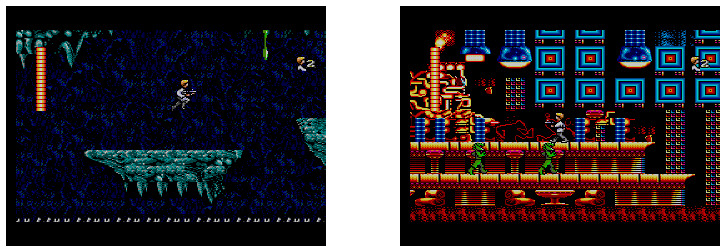
Ported from its original NES version by the British developer Tiertex and released by British publisher U.S. Gold in Europe, and by Brazilian publisher Tec Toy in South America, the game had an added easier difficulty option (Cadet), besides the original difficulty (Jedi). But even before choosing the difficulty, or even turning on the console, the little nerd boy was already enamored not only with the game itself, but also with that amazing universe, cradle to imagination, thanks to the instruction booklet that came with it. Much longer than other games’ booklets, that one went into great details about the places, friends and foes that any player could meet if the challenge to enter that far away galaxy was accepted.
Starting on the surface of the planet Tatooine, the player as Luke Skywalker with C-3PO, should rescue R2 from the Jawas and take the robot's message to Obi-Wan. These parts are side-scrolling stages separated by a top-down desert hub where the landspeeder could be controlled. After acquiring shields for a spaceship in different caverns spread throughout the planet (not exactly like in the movie), Luke would enter the Cantina. With that unforgettable tune playing in the background, he would get the help of scoundrel Han Solo and his partner Chewbacca.
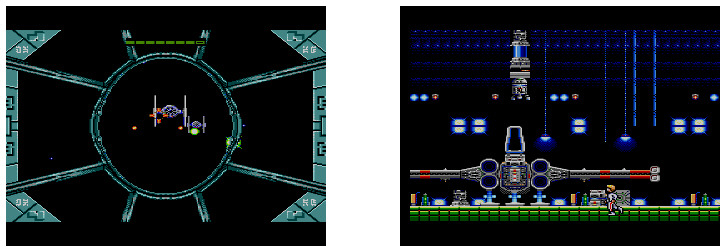
From there on, the Millennium Falcon would be controlled in first-person mode while the player tried to cross the Alderaan debris. The Death Star was a gigantic labyrinthine side-scrolling stage where Luke - or Han - would rescue Leia. Fly through air tubes (a bit of Episode V thrown in), fight the trash compactor monster, and cross a section full of killer metal thorns on the ground (the most difficult section of the game, and again, not exactly like in the movie). Back to the Falcon, gamers would fight another first-person section against TIE Fighters before piloting the X-Wing against more TIEs to return to the Death Star. Then enter the final, heroic, tense, unforgettable and super-famous trench run, where the X-Wing was controlled in a top-down perspective like the landspeeder at the beginning of the game, which helps the game feel cohesive.
So yes, Star Wars on the Master System took the expected route for film adaptations: The multi-genre option. But it was a very good multi-genre video game, where no section suffered from bad controls. There were some short animated scenes, and lots of stills from the movie, to advance the story. The graphics were very detailed and the soundtrack had an authentic Star Wars feeling. And that was exactly the main strength of the game, being so authentic, so alien and so familiar at the same time, as every Star Wars product must be. One of the best licensed platformers on a system which had no shortage of them.
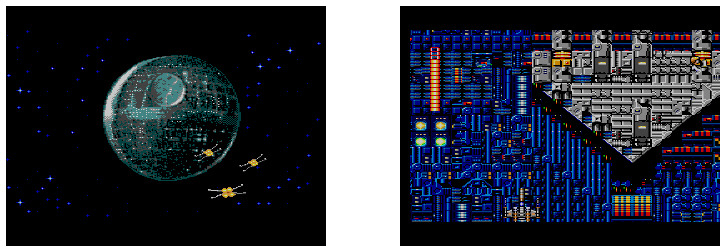
Note: The Game Gear version, released
in the USA, is a completely different game. Usually, Master System games
were ported with no modifications to the portable system, but this one
was a rare exception.
|
This article will be looking at the various
Pac-Man games that were released for the Atari 2600 during its commercial
life and the newer versions released by various homebrew programmers since
then.
A Brief History of Pac-Man
In the year 1980, Namco released a game in Japan under the name Puck-Man. The game would come to the United States after the folks from Midway Games licensed it from Namco only a few months later under the name Pac-Man. The rest, as they say, is history. Pac-Man became an instant hit and created a whole new genre of arcade gaming in and of itself. At the time, most arcades were full of space shooters, so a game that had no shooting elements was something totally different. Though the basic gameplay of the game was simple, move a yellow character while avoiding monsters and eating dots, it was highly addictive and a type of gameplay that appealed to people of all ages.
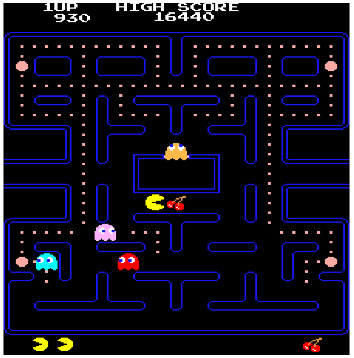
Pac-Man (Arcade)
Pac-Man became one of the highest grossing video games ever made and remains popular even today, more than 30 years later. Not only have there been sequels to the original game, but even a TV show, board games and many unlicensed versions. In fact, there were multiple clones of the game produced as well and new arcade games that tried to use the same formula but that added new elements to the gameplay. None were as successful as Pac-Man.
Given the popularity of Pac-Man in the
arcade, it was to be expected that ports of the game would be created for
the home consoles of the time. The company who won the rights to
create the first home port of the game was none other than Atari, who promptly
announced they would bring Pac-Man to their Atari Video Computer System.
Needless to say, there was much excitement with the news and people were
eager to see what Atari would release for their home gaming system.
Commercial Releases
The Atari 2600 received three ports of Pac-Man games through its commercial life. These games were Pac-Man, Ms. Pac-Man and Jr. Pac-Man. These games demonstrate a progression in game development for the console and how Atari learned some lessons after the release of Pac-Man. Let's now look at each of these games.
Pac-Man
Atari released their port of Pac -Man for the 2600 on March 16, 1982. The game was programmed by Tod Frye and it became the best selling game for the system, with 7 million copies sold. Despite becoming the highest selling game for the 2600, the game has been criticized for being a poor port of the arcade game. This criticism came from the many differences found between this version of Pac-Man and the original arcade game. The overall gameplay remained the same, with the player controlling Pac-Man in a maze to eat "dots" and avoid the ghosts, but the game looked nothing like the arcade game. The maze was now orange with a blue background, the ghosts flickered constantly and did not appear to have different behaviors nor did they have the four colors seen on the arcade game. Pac-Man now had an eye and only looked left or right even when moving up or down in the maze. Gone were the fruits and other prizes in the center of the maze, replaced with square "vitamins" and the dots were now rectangular wafers. The game sounds didn't even come close to emulating any of the arcade sounds either. The opening theme music, the "waka waka" sound Pac-Man made and the siren were nowhere in this port. The scoring was also different as it only represents one tenth the score from the arcade. Of course, many of these differences were due to the limited hardware on the 2600. Tod Frye had four months to develop the game so he had to make compromises during his development of the game. He was also restricted to creating a 4K ROM instead of an 8K ROM, and he needed to keep the ability to play a two-player version of the game.
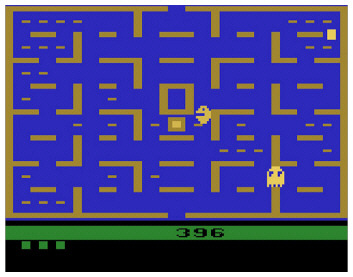
Pac-Man (Atari)
Through the years, there has been much talk about the failure of Atari's Pac-Man in capturing the magic of the arcade. Many have felt that game was rushed in order to cash in with the Pac-Man fever and Atari just felt that making a game with similar gameplay was more than enough to get people to buy their version of Pac-Man. Though they sold 7 million copies, they had 5 million copies left as they had made more cartridges than there were 2600 consoles sold, so Atari took a financial hit thanks to this game. They did learn a lesson, though, and future games in the Pac-Man family were programmed to be closer to their arcade counterparts.
Ms. Pac-Man
Ms. Pac-Man was the follow up to Pac-Man in the arcade, seeing release in 1982 and improving upon the original formula of the game. Of course, Atari had to release a version of the game for the 2600 and they did so in 1983. This time the game was programmed by the team from GCC, the same team that developed the arcade version of Ms. Pac-Man, and every effort was made to bring something closer to the arcade on the 2600. Were they successful? Absolutely!
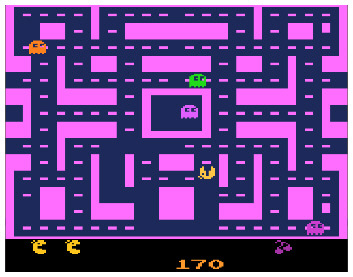
Ms. Pac-Man (Atari)
Ms. Pac-Man on the 2600 had a title screen with the lady Pac and the ghosts, each of which had its own color. The mazes kept elements from the arcade and there were four of them as well. The opening tune was included and the overall gameplay was as close to the arcade as it could be. The fruits and other moving prizes were also included and the only thing missing were the intermissions. To accomplish all this, the game had an 8K ROM and there was no two-player option. Despite this, the game was well received and demonstrated that with greater effort an appropriate port of a Pac-Man game could be brought to the system.
Jr. Pac-Man
As impressive as Ms. Pac-Man was on the 2600, Atari truly impressed even more so with their release in 1987 of their adaptation of Jr. Pac-Man for the console. Jr. Pac-Man was released in the arcade in 1983 and it expanded the Pac-Man formula further by making the mazes so large that they scrolled horizontally on the screen. These mazes did not feature escape tunnels like Pac-Man or Ms. Pac-Man did, however. In adapting the game to the 2600, Atari compromised by making the mazes scroll vertically rather than horizontally, but they did their best to reproduce the seven mazes from the arcade game.
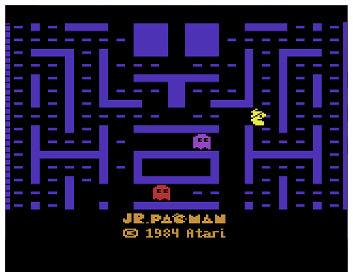
Jr. Pac-Man (Atari)
They were, essentially, turned sideways.
Every element of the arcade was included and, despite missing the intermissions
themselves, the music for these was included. All the fruits and
other prizes were included and they also exploded when they touched an
energizer. Jr. Pac-Man not only impressed with its gameplay and graphics
but with its sound effects as well. Atari programmers had clearly
learned how to get better sounds out of the TIA chip by the time this game
was developed because it clearly did a superb job in recreating the
arcade sounds and music.
Homebrew Releases
One thing that can be said about the Atari 2600 is that it has a large homebrew developer community. Through the years, many of these developers have tried to bring home a better version of Pac-Man to the console given the latter examples of improved ports on the system. To date, seven new versions of Pac-Man games have been released by homebrew programmers, so let's look at each of these.
Pac-Man
In 1999, the team from Ebivision (Eric Bacher & Igor Barzilai) made their own version of Pac-Man for the Atari 2600, though they did not release it in cart format. This game was a hack of another puzzle game Ebivision had developed called Pesco. This version of Pac-Man reproduces the original maze but widens it to fit the screen.
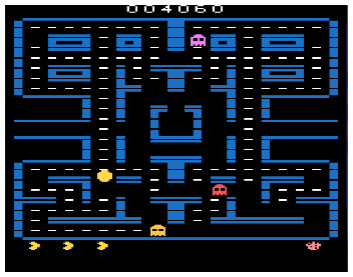
Pac-Man (Ebivision)
The "dots" are white against a black background and Pac-Man is rounded and faces the direction in which he goes. The ghosts each has a different color and they behave closer to their arcade counterparts. The sound effects are a significant improvement over Atari's Pac-Man but they are different from the arcade. A siren sound does play in the background, though, which is a key feature for a port of Pac-Man. Though the intermission screens are missing, all the fruits and prizes are here and appear under the ghost pen as in the arcade. Overall, this is one nice port of Pac-Man for the Atari 2600.
Pac-Man Arcade
Another version of Pac-Man was released by programmer Rob Kudla for the 2600 but, this time, the game was made as a hack of Atari's Ms. Pac-Man. On this version, the maze and the "dots” are of the same color and the maze is an approximation of the arcade's maze, rather than a close match like Ebivision had done. The maze walls are blue and the background is black, though, to match the arcade. The fruit all appear under the ghost pen and remain stationary as they're supposed to be. The opening theme was changed to better match Pac-Man's and the siren was also added but other sound effects are like those of Ms. Pac-Man. Overall, this is probably something that could have been released back in the 1980's and it would have likely been better received than what Atari originally released.
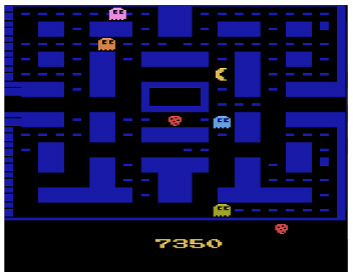
Pac-Man Arcade (Rob Kudla)
Pac-Man 8K
The original Pac-Man for the 2600 was a 4K ROM, so what could be done with the game if the ROM size is increased to 8K? Well, this is what homebrew programmer Kurt Howe wanted to find out and so was Pac-Man 8K born. This version has a variety of changes made to the original game. First the color scheme of the maze was changed to at least be closer to that of the arcade. Now we have blue maze walls on a black background with white "dots" for Pac-Man to eat. Pac-Man's shape has been modified so his mouth opens and closes properly, he has no eye, and he moves correctly through the maze. The ghosts are all rendered in different colors and, though they do still flicker, they don't do so as much as before.
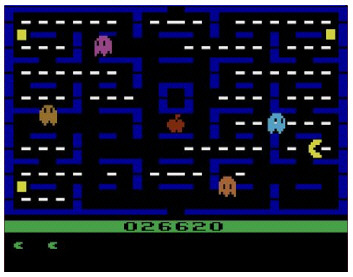
Pac-Man 8K (Kurt Howe)
The bonus items have all been restored as well, so now there are cherries, strawberries, oranges, etc. for Pac-Man to gobble up. Oh, did I mention there's also a title screen? The intro music has been changed to resemble the arcade version, the siren has been added, and several other sounds have been modified, though the loud clanking sound is still here as Pac-Man eats the "dots." The life counter has little Pac-Men that are animated also and even the intermissions have been included! The game does allow for one or two players and also has eight variations. I think criticism would have been friendlier had this been what Atari released back in the day. While this remains Atari's Pac-Man, given the maze design, it is closer to the arcade in other respects making it a much more enjoyable version to play.
Hack'Em
Kurt Howe didn't stop with hacking the original Atari Pac-Man. In 2005 he also hacked Ebivision's Pesco to create his own version of Pac-Man, which he called Hack'Em. This version actually improves upon what Ebivision's team created in their Pac-Man hack of the same game. The music intro has been added and the sound effects have been improved to try to emulate the arcade sounds more closely. There's even a fully rendered and animated title screen which has Pac-Man move across the screen followed by the ghosts along with a chart that has the ghosts and their names. Hack'Em has all the fruits and prizes but differs from other hacks/homebrews in that the score, lives left and the fruit level you're playing appear at the top of the maze. This version also adds the intermission screens. The music is off-key on these, but the important fact is that they appear! Hack'Em plays much faster than other versions of Pac-Man as well and is more like the "Turbo" mode seen in some arcade machines. It is a blast to play and much more closely resembles the arcade original. Of course, the maze is stretched horizontally but that doesn't matter. It represents the arcade game much better.
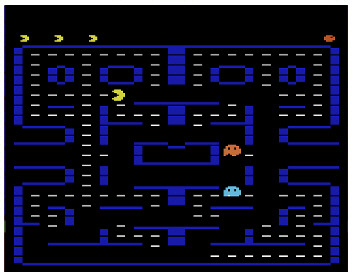
Hack'Em (Kurt Howe)
Ms. Hack
So, Atari gave us a great version of Ms. Pac-Man for the 2600, right? Yes, but how about making something even better. Here we have Kurt Howe to thank again. He hacked his hack and created Ms. Hack in 2006, a version of Ms. Pac-Man that is as close to the arcade as it gets. Even the red lipstick and red bow are on this round lady of the maze. The game uses flicker to its advantage to create these elements (which also makes it quite difficult to get an accurate screen capture!). Ms. Hack feature all four mazes from Ms. Pac-Man with grater accuracy than Atari's version of Ms. Pac-Man. Not only do the mazes look closer to the arcade's but they also have the right colors. Even the "dots" also change colors as they are supposed to for each maze. Like Hack'Em, Ms. Hack plays at "Turbo" speed which is cool as it usually lets you play for longer. Sound effects also resemble those of the arcade more closely. Overall, an excellent version of Ms. Pac-Man for the 2600.
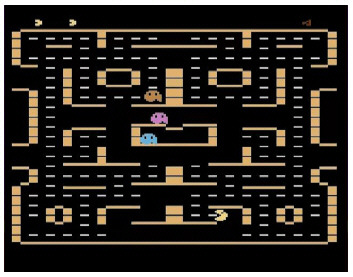
Ms. Hack (Kurt Howe)
Pac-Man 4K
Working within the same memory limit as the original Atari programmer, Dennis Debro has created a version of Pac-Man for the 2600 worthy of admiration. Pac-Man looks round, the ghosts each have their unique color and personalities, and the maze looks as arcade-perfect as is possible on the 2600. Bonus items appear in the center of the screen under the ghost pen and these include the cherries, strawberries, peaches, etc. all here beautifully rendered! Yes, the maze has been stretched to fit the screen but it is as it should be. Even the "dots" on the maze are white! And looks are not the only area where this game excels.
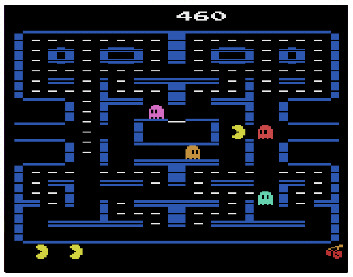
Pac-Man 4K (Dennis Debro)
In the sound department we now get the siren which even changes pitch like in the arcade when Blinky goes into "Cruise Elroy" mode. While the arcade "waka waka" sound can't really be reproduced on the 2600, the sound of Pac-Man eating the dots is pleasant to hear. Other sounds like the intro music, the energizer effect, eating the bonus items, and Pac-Man's death are nicely reproduced and reminiscent of the arcade. Though some sacrifices were made (i.e., there are no intermissions) due to the memory limitation, this port of Pac-Man should not be missed in any 2600 collection. It is far superior to Atari's Pac-Man in every way.
Pac-Man 4K/8K
Just when we all thought that we had the ultimate version of Pac-Man for the 2600 thanks to Dennis Debro, in comes Daniel Goncalves in 2014 and blew us out of the water with his version of Pac-Man. Not only does this version looks as great as Dennis Debro's version but it sounds even better! The opening music, the siren, the ghost eyes moving back to the pen after the ghosts are eaten by Pac-Man, the energizer sounds, they are all here with remarkable accuracy. Because this ROM is 8K, the intermissions are also included and the music that plays in these is more accurate than what we have gotten in other hacks/homebrews that have been made. All the other game elements are also right here, making this the ultimate version of Pac-Man for the 2600 as of this writing.
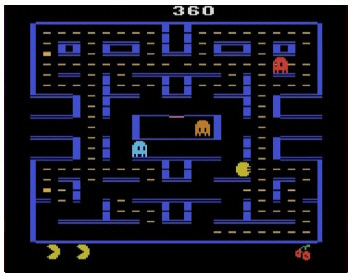
Pac-Man 4K/8K (Daniel
Goncalves)
Concluding Remarks
Pac-Man's legacy long lives on the Atari
2600 even to this day as newer programmers take on the challenge of creating
more accurate versions of the game for the system. Thanks to homebrew
programmers we have various improved versions of Pac-Man and Ms. Pac-Man
for the 2600 with only Jr. Pac-Man being left pretty much untouched or
reproduced in any other way. Clearly newer programming techniques
and greater resources have made it possible to develop better versions
of these games and time will tell what else we'll get to see. For
now, any fan of Pac-Man or its sequels has plenty of versions to choose
from to enjoy.
|
In 1982 the home console market was dominated by the Atari 2600 and Mattel's Intellivision. Many had tried to compete but failed, until ColecoVision came along. Coleco delivered by being the first to put a computer processor, the Zilog Z80, into a home video game console. Although this increased the cost, it allowed Coleco to deliver near arcade quality for its time. The other factor in ColecoVision breaking sales records was their first Expansion Module, allowing it to play Atari 2600 games. The standard controller used a little stick with a knob on it, it also featured a numeric keypad built into the controller itself, plus two fire buttons. The controller was a bit similar to the Intellivision. At first glance you may think it was the same controller, using the same concept of the number pad to control the action. Rather than the disc shaped control pad of the Intellivision, the ColecoVision used a knob at the top to control movement. This made things much more comfortable to play, in my opinion.
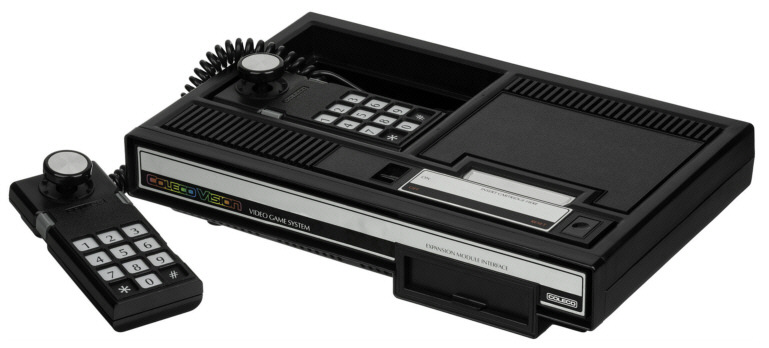
Many games were released for the ColecoVision system, including Burgertime, Centipede, Donkey Kong Junior, Frogger, Jumpman Junior, Q*Bert, Zaxxon, Pitfall, and Mouse Trap. The games were very good and had clear, crisp graphics with lots of colors. The ColecoVision had a large library of games considering it only lasted a few years.
One of the best games was Donkey Kong. It is the original arcade version where you must climb ladders to ascend to the top of the stage where your girlfriend is tied up and being held captive by the giant villain, Donkey Kong. To reach his girlfriend Pauline, Mario must climb up or down ladders and scale each screen. Jump or avoid the barrels and objects thrown down by Donkey Kong with just the right technique. Mario can also grab a hammer and with it Mario can hit barrels or fireballs for points but Mario can't climb ladders or jump while holding the hammer. When the hammer disappears a few seconds later, Mario must avoid the obstacles once again.
Zaxxon is a 3-D space game that takes you across alien asteroid fortresses on a special mission. The evil robot Zaxxon and its fierce armies have conquered an asteroid belt. You must stop them before they enslave the entire galaxy! Pass the barrier on the first asteroid, then dive to the enemy surface. Evade fire from gun turrets and robots as you search for the Robot Warrior. Once you successfully cross the asteroid fortress, you must fly through deep space. Mouse Trap features a cheese chomping mouse that you dash around a maze. Open and shut maze doors to escape the pursuing cats. Eat a bone and then turn your mouse into a cat-biting dog for offense. Pressing a red, yellow or blue button (1, 2 or 3) as shown on the overlay opens or closes all doors of that color. Pressing the green button (5) as shown on the overlay changes your mouse into a dog and allows you to attack.

In its short two-year life, the ColecoVision
sold over six million units and made a permanent mark as one of the highest
quality and advanced home video game consoles of the 80s. The ColecoVision
held onto the market until 1984 when Coleco exited the electronics business
to focus primarily on their toy lines such as the Cabbage Patch Kids.
The controller is not very well known but an important one in the video
game console history.
|
Every Friday on The Retrogaming Times Facebook page (facebook.com/theretrogamingtimes), we present a Weekly Retrogaming Trivia question. This just-for-fun trivia challenge provided each week is an opportunity to test your arcane and oddball retrogaming knowledge. The answer to the question from the previous week is posted along with a new trivia question every Friday!
Below is the recap of all questions and
answers posted between this issue and the previous issue:
04/27/2018 - WEEK 64
Question: What was the
only Coleco tabletop VFD game to require D size batteries?
05/04/2018 - WEEK 65
Question: What game
featured the first appearance of Konami mascot character Konami Man?
05/11/2018 - WEEK 66
Question: Released on
the same day, what two games were the first Famicom titles that Nintendo
later declined to release outside of Japan?
05/18/2018 - WEEK 67
Question: Nintendo's
MMC6 Memory Management Controller chip was only used in what two games?
Weekly Retrogaming Trivia took a two-week hiatus during 05/25/2018 and 06/01/2018.
06/08/2018 - WEEK 68
Question: The Dreamcast
release Daytona USA 2001 (known as Daytona USA in North America) features
many unlockable cars. Due to the closure of Sega's online service, what
car can no longer be obtained?
06/15/2018 - WEEK 69
Question: What NES title
infamously required the original documentation in order to access the game's
later half?
06/22/2018 - WEEK 70
Question: What was the
first Sega developed video game to be released on a Nintendo home console?
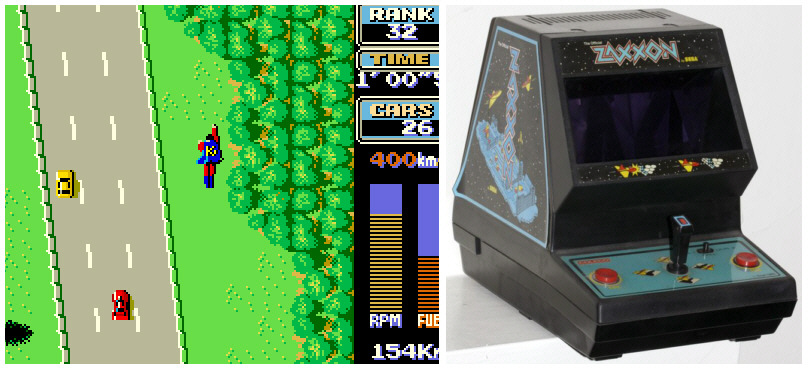
Konami Man debuts in
Road Fighter (left), Coleco's Zaxxon tabletop was massive both in size
and power consumption (right)
Answers:
Week 64 Answer: Zaxxon, due to its
mirrored dual display.
Week 65 Answer: Road Fighter, originally
released to arcades in 1984.
Week 66 Answer: Gomoku Narabe Renju
and Mahjong.
Week 67 Answer: StarTropics and
Zoda's Revenge: StarTropics II.
Week 68 Answer: Red Cat, unlocked
by winning an online race.
Week 69 Answer: StarTropics, the
game requires a frequency number be entered at the end of Chapter 4. This
is revealed by dipping a paper included with the instruction booklet into
water.
Week 70 Answer: Super Monkey Ball
(2001), on the Nintendo GameCube.
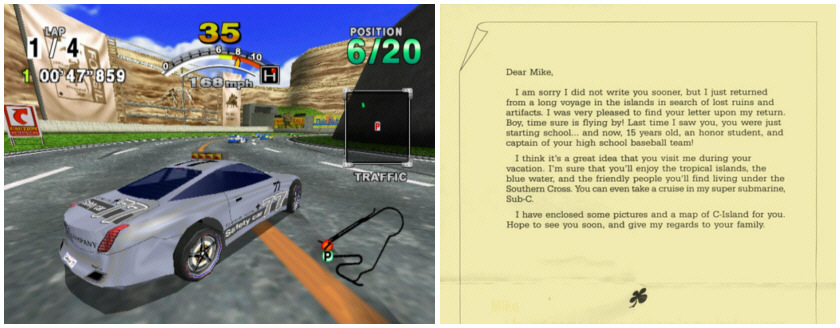
Daytona USA 2001's Red
Cat (left), StarTropics included a special letter with a required hidden
message (right)
Don't be left out! Be sure to follow The Retrogaming Times on Facebook for a new retrogaming trivia question every Friday!
We need your questions! If
you have a trivia question you would like to submit for possible inclusion
in the Weekly Retrogaming Trivia question pool, e-mail it to trt@classicplastic.net!
If you question is selected to be featured, you will be entered in our
year-end prize drawing!
|
As this issue of The Retrogaming Times goes to publication, Toys "R" Us will have discontinued all operations in the United States. While the reasons for their bankruptcy and eventual total liquidation go beyond the scope of our newsletter, Toys "R" Us played an important role in the revival of the American home video game industry in the mid 1980's. By 1982 the American video game industry was riding high. Although the Atari VCS / 2600 was looking very long in the tooth, it was still massively popular with a huge installed base and new games being constantly released. However its unregulated success would also be its undoing.
As anyone could release a commercial Atari 2600 cartridge, countless game companies were created to develop for the hardware. Additionally media conglomerates and other businesses that were otherwise unrelated to the video game industry, began creating video game subsidiaries to cash in on the home gaming trend. Many of the games pumped out by these ventures were of poor quality and didn't sell very well, leading to them being marked down to clear shelf space at retail as their development houses went under. On the other side of the coin, companies such as Atari, Activision, and Imagic were releasing first-rate quality games at full price. Ultimately this gave the consumer a choice: purchase a single Activision game for $40, or buy eight clearance games for $5 each. In an era when digital media information was reasonably limited, or at the very least not mainstream, most consumers would elect to purchase eight games of questionable quality over a single game of higher cost. Not surprising, as eight Christmas gifts as opposed to one for the same money seems more sensible on the checkbook. The problem came when the quality developers began to loose money, their products drowning in a sea of clearance cartridges. Essentially the home video game industry had begun to collapse under its own weight. Home video games were subsequently labeled a fad and brushed aside as a passing trend by the time 1983 rolled around.
However people still wanted to play games. Nintendo was having success in Japan with their Family Computer, also known as the Famicom, released in 1983. Although they had made attempts to bring their console to the United States, none of them had come to fruition. Nintendo was very observant, saw what lead to the downfall of home video games stateside, and decided on a new approach. All game licensing and cartridge manufacturing would be handled by them, even for third-party developers. Their game system would have a digital software lockout, preventing unlicensed games from flooding the market. They would replace the phrase "video game system" with "entertainment system" and call their cartridges "Game Paks." A lightgun and toy robot would be included with the system initially, giving the entire product the representation of a high-tech toy rather than a home video game system. Retailers were still skeptical so Nintendo offered to handle all marketing, require no up front payment for shipments, and would accept all unsold merchandise after 90 days. It was a risk free offer, and Toys "R" Us was one of the largest retailers to take Nintendo up on their generous program.
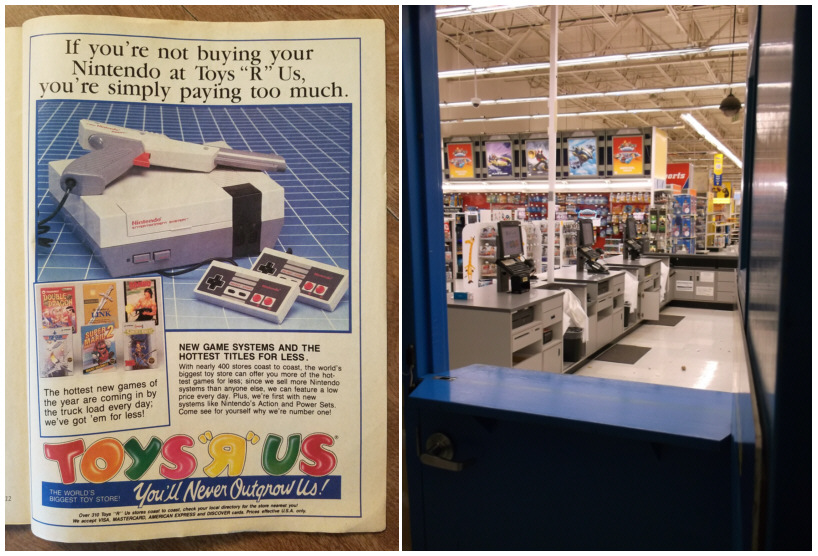
An advertisement from
"The Game Player's Guide To Nintendo Games" 1988 (left), looking out the
electronics stockroom door at TRU5813 (right)
The rest, they say, is history. The Nintendo Entertainment System exploded in popularity and became synonymous with video games. The home gaming industry was back and would continue to grow until this very day. Toys "R" Us became the go-to destination for Nintendo hardware, games, and merchandise, with large areas dedicated specifically to the company for nearly a decade. Grabbing the paper ticket for the game you wanted to purchase, paying for it at the register, and then taking the ticket and receipt to the employee at the stockroom window to get the game was always exciting to me as a kid. In 2008 I relocated back to Silicon Valley, to the neighborhood I grew up in. When looking for work to get set up since moving, I took a job with Toys "R" Us at the very store I frequented as a child. I didn't intend for it to be anything other than a temporary position but through a twist of fate it became a career. As my background was in consumer electronics, the electronics department became my pet project. My philosophy has always been that a big-box store electronics department should be the crown jewel in the entire operation. Although self-service and display cases became the norm for video games, merchandise tickets were still used for very high dollar items or during high traffic days such as Black Friday. I became the guy at the stockroom window, standing on the other side of the door I stood at countless times as a kid. The whole thing came full circle.
I parted ways with Toys "R" Us in early 2016, long before the recent restructuring, bankruptcy and liquidation. Although our store was one of the most consistently profitable and highest rated in the company, the ever increasing values of Silicon Valley real estate ultimately became too lucrative to ignore. The store had been there so long that Toys "R" Us actually owned the entire property it was built upon. It was subsequently sold for a massive neighborhood real estate redevelopment and the doors closed for the last time that February, after over four decades in operation. While Toys "R" Us may have not been as important to the modern video game player over the past few years, it's important to understand and remember how critical they were to getting home video games going again on a national scale. Would the industry have returned if they didn't take a chance on the NES during its early days? Absolutely. However it would have all played out very differently from the history we know.
Thank you once again for reading The Retrogaming Times. We'll be back on September 1st with our next issue. Be sure to follow The Retrogaming Times on Facebook and join our community for the latest updates and information! Additionally The Retrogaming Times Info Club on Twitter features up-to-the-moment news and notifications for all things The Retrogaming Times! I sincerely hope you enjoyed this issue and that you will return to read the next issue and possibly submit an article yourself. Remember, this newsletter can only exist with your help. Simply send your articles directly to me at trt@classicplastic.net or check out the submission guidelines on the main page. Submit an article today and join a great retrogaming tradition!
See You Next Game!

Content and opinions on this
page are those of their respective writer(s)
Assembled and published
by David Lundin, Jr. on July 1st, 2018 at ClassicPlastic.net
© 2018 The Retrogaming
Times. All Related Copyrights and Trademarks Are Acknowledged.